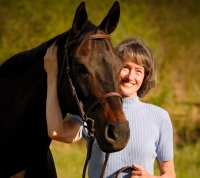TRUE TRAINING 75 - The Season of Mud and Fur
Happy Spring! The birds are chirping, crocuses are poking through patches of snow, the sun's out, and temperatures are starting to rise. There are no flies yet and the days are longer... which means more time to ride! New foals are born, like the cutie on my Facebook page today. After a long winter, spring always feels good.
It does carry a few small annoyances, though. In equestrian parlance, welcome to The Season of Mud and Fur. True enjoys daily mud baths in our thick clay soil. He seems to spend most of the day wallowing in the muck, squirming it up inside his ears, between his hind legs, deep into his poll and withers, and under his tail. When he's accomplished that, all the other spots are covered, too.
His black mane appears to be braided in mud dreadlocks most of the time. Every now and then, he creates a frosted-tips look: Remember? Like boys in the 1980s who bleached only the ends of their hair, then gelled it upward into curved spikes. To match the mane, fist-sized clumps of mud swing from the long hairs on True’s tail.
True’s Sasquatch feet pick up enough wet mud to fill a five-gallon bucket most days. As we walk from his turnout, they enlarge gradually. Each muddy hoof attracts more mud, until he is slip-sliding around on giant brown dinner plates. Ahhh, spring!
True lives in a dry climate. So after a few good squirms in the deep clay mud, he dries like a Chinese vase. I can tap the outer crust and hear a hollow ping. He’s bay but has hardened into a palomino. Apply a metal curry comb to this porcelain exterior, and you got nothin’. The metal scrapes uselessly over the top of the hardened mud, and I practice my swearing vocabulary.
It’s too cold to add water, but with concerted effort and a lot of elbow grease in short strokes, I eventually get past that outer shell into mud that has dried to a softer consistency, like a damp road just soft enough to be driven flat. Now the work can begin. This softer dirt evaporates into dust more easily, raising a plume of dust that the April wind blows into your nose and eyes. My goal is to chip out a clean spot where True’s saddle will go. The rest is going to have to wait. Fortunately, True is willing to stand for “grooming” of this sort. Many horses don’t.
As I go deeper, small speckles of True’s hair become visible and a little fur begins to emerge. Soon it’s coming out in mud-encrusted clumps. Now I am covered with dust and fur, breathing falling onto my clothes, catching in my ears, irritating my eyes. I’ll bet you know the feeling. It sticks to the magnet of my fleece jacket and adheres to the chapstick on my lips. Most of the dust and fur I’ve taken off True has now adhered to me. What a gem! This is just the kind of rare moment when a tall handsome horseman saunters into the barn looking for conversation.
Combined with cold spring winds, the season of mud and fur continues for weeks. Just as the mud begins to solidify, it rains or snows again—or both. When True is finally cleared of his baked mud shell and shedded out enough for one day, his skin is still filthy. But let’s not look at that! Instead, I will put him away. And what will he do? Sniff his hay for quality and reassurance, then go roll in the mud.
Remind me: Why do we do this again? At least we’re all in it together. A whole group of people sputtering on fur, eyes gleaming through half an inch of facial dust. Horses rolling in glee, scratching an entire winter’s worth of itches. Hooves too muddy to find, mud boots too heavy to lift, and car seats upholstered in a dusty bay color with a very hairy texture. Washing machines working overtime, filters plugged with horse hair, plumbers on speed dial.

